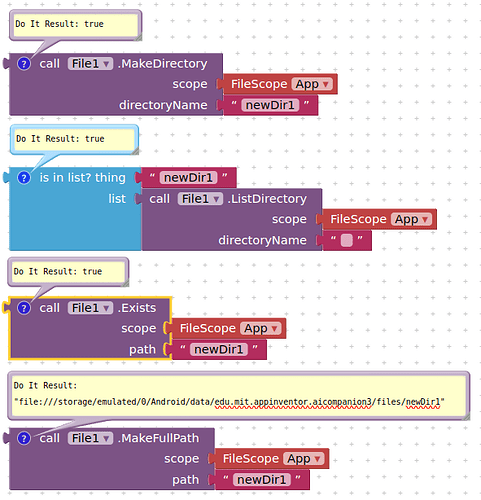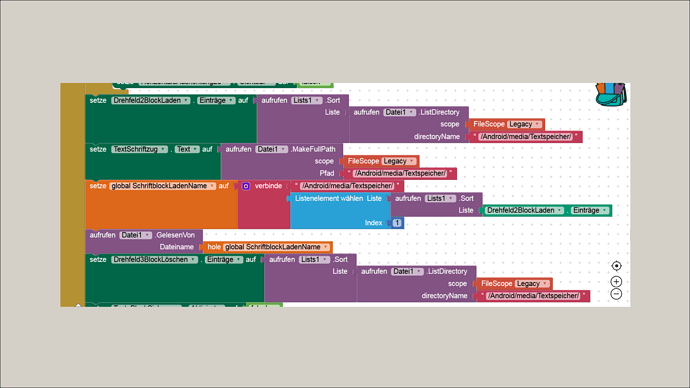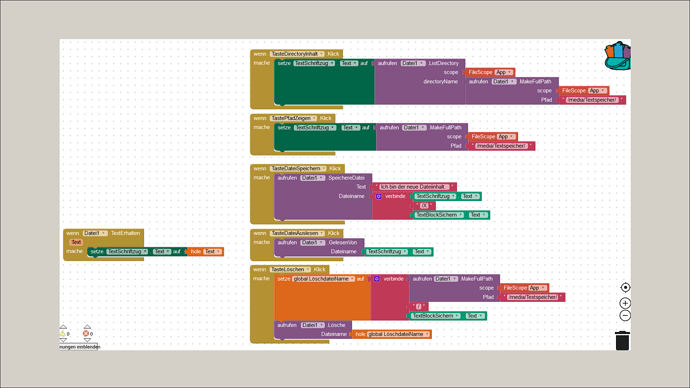And ... where is the problem with that?
will it not be a problem with Android 11?
If you set DefaultFileScope = Legacy in the Designer it should work also on Android 11+.
I'm honestly getting desperate, this chaos with the path information and the locked data area since V13 :-/
What path information should be if I want to save and read something under internal storage/Android/media/, whether it's an asset or shares or an app? Can someone please give me a comprehensible and logical explanation? I'm slowly losing interest in AI. Thanks
There is no such path...
Show with your blocks what you are attempting, then maybe we can help demystify...
Also confirm your Android version.
You can't on Android 11+ without SAF or without granting MANAGE_EXTERNAL_STORAGE permission. But you can read media files with the respective READ permissions.
See also here:
My problem is: I built an app under Android 10 in which Rich can create a directory in the folder Android/data/"App-Version"/files without any problems. Unfortunately, this no longer works under Android 13 or later. So I am forced to choose a folder that is writable and readable from the app and everything. So I have been experimenting for hours with all possible combinations to create the folder to store text files in. The "media" folder would be suitable for this because it is readable and writable and not locked like the "files" folder in Android 13. I just have no idea anymore, I have installed it 100 times and it's always wrong. Thanks for help that even I, as a beginner, can understand.
Did you read my guide(s)?
If so, what / where exactly is the problem then?
I have a lot of trouble understanding English translations. And there are so many threads and instructions and questions online that it's easy to lose track.
Do you need more than this?
The directory newDir1 is in your ASD, and therefore readable and writeable by your app.
Instead of installing it 100 times, you should read my guide carefully once.
Maybe, but (without sounding arrogant) my guide is enough.
Use ASD, i e. the solution provided by @TIMAI2
However if additionally you want to use those files in other spps or you want to be able to see them in a file manager app, then store the files in shared storage, for example /Download or /Documents
Taifun
PS: yes, the guide by @Anke is all you need
Bei mir schreibt er es immer wieder in den data-ordner. Ich versteh auch nicht, warum er die Dateien für den Listpicker eim Öffnen findet (stehen ja dann drin und werden aus dem verzeichnmis gelesen bdeim Listpicker füllen), aber wenn ich sie auswähle, findet er sie nicht (could not be found ....) ? Ich kriege eine Knall hier. Wie soll ich das nur erklären?
Das steckt in der ScreenInitialisierungs ....
Um es abzukürzen, poste mal eine simple Text-AIA, die das Problem aufzeigt.
Ich habe inzwischen paar Stunden herumexperimentiert und es hinbekommen, Dateien zu speichern und diese auszulesen wie auch die Verzeichnisse aufzulisten. Android schreibt die Dateien halt in irgendwelche imaginären Speicher, die man zwar aus der selbst geschriebenen App händeln kann, aber über das Smarphone selber und dessen Speicherhirarchie nicht auf diese zugreifen kann, selbst die Suche findet keine Datei, die ich jemals über meine App gespeichert habe. Das ganze Theater nur, weil die Entwickler von Android der Meinung sind, Benutzer sollten das App-Verzeichnis nicht mehr sehen und bearbeiten dürfen, auch wenn es sich dabei nur um den Ordner "data" handelt. Einfach grauslig.
I've experimented for a few hours now and managed to save files and read them, as well as list the directories. Android writes the files to some imaginary storage that you can handle from the app you've written yourself, but you can't access them via the smartphone itself and its storage hierarchy. Even the search function doesn't find any file that I've ever saved via my app. All this is just because the Android developers think that users should no longer be able to see or edit the app directory, even if it's just the "data" folder. Simply awful.
Ja, da bin ich definitiv bei dir. Und das geht weit über die (Nicht-)Sichtbarkeit des ASD auf Android 11+ hinaus. Die permanent zunehmenden Gängelungen und Restriktionen sind schlechterdings unerträglich. Mal abwarten, was uns targetSdk=34 ab 31. Aug. 2024 und die Folgejahre noch bescheren werden.
Aber wie ich schon mehrfach an diversen Stellen sagte, ich bin sehr optimistisch, dass dieser Spuk (Einschränkungen der Freiheit -- immer natürlich zum vermeintlichen Nutzer der User) schon sehr bald zu Ende gehen wird.
Im Übrigen, kann das ASD natürlich auch auf Android 11+ eingesehen und bearbeitet werden, wenn man das Gerät per USB mit dem Computer verbindet.
Yes, I definitely agree with you. And that goes far beyond the (non-)visibility of the ASD on Android 11+. The constantly increasing restrictions and constraints are simply unbearable. Let's wait and see what targetSdk=34 will bring us from August 31, 2024 and the following years.
But as I have said several times in various places, I am very optimistic that this nightmare (restrictions on freedom - always for the supposed benefit of the user, of course) will come to an end very soon.
The ASD can of course also be viewed and edited on Android 11+ if you connect the device to the computer via USB.
Gelassene Vorstellung " ich bin sehr optimistisch, dass dieser Spuk (Einschränkungen der Freiheit -- immer natürlich zum vermeintlichen Nutzer der User) schon sehr bald zu Ende gehen wird". Was sollte sie daran hindern, so weiterzumachen? ![]()
Calm thought "I am very optimistic that this nightmare (restrictions on freedom - always of course to the benefit of the users) will soon come to an end". What should stop her from carrying on like this? ![]()
Alle Big Techs waren am "Crime of the Century" beteiligt. Diese Statement sollte klar genug sein. Wie auch immer - ich werde es einstweilen dabei belassen.


